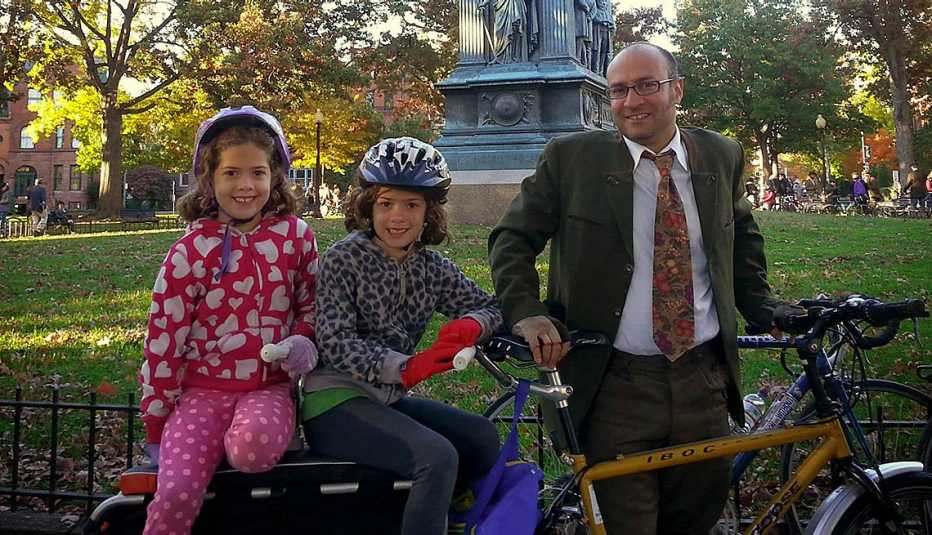AARP Hearing Center


En español | Living car-free is not for everyone, no matter how dedicated someone is to saving money and the environment.
Before leaping, give car-free or car-lite living a test spin first. Some folks realize by happenstance that they don't need two cars (or even one). Arlington, Virginia's Car-Free Diet program offers illuminating information as well as videos about skeptics who accepted a challenge to live car-free for a month.
1. Dress for success
Pack the high heels in a backpack and choose the warmest hat, not the most stylish. Sturdy shoes, comfortable clothes and reliable rain-gear are paramount. Visit an outdoors store and check out the many high tech clothing solutions for rain, snow, heat and cold. "Thanks to lightweight warm clothing you don't have to pile on thick coats and three layers of mufflers like you once did. It's much easier to enjoy yourself outside," says open streets expert Gil Penalosa — who was born in Colombia and now lives in Canada.
2. Make a plan
Keep a list of errands to be done outside the home, and handle as many as you can on a single trip to save time. Buy a tote bag or pack for carrying the everyday items you used to store in your car.
3. Give yourself a little more time
"Living without a car is leaving me breathing room between the things I plan to do," says Patricia Blakely in her book Carfree Living. She finds that a less packed schedule opens up room for more serendipity in her life. Bring a book or just watch the world go by if you find yourself arriving early.
4. Play it safe
If it's late at night, you're in unfamiliar territory or the weather looks threatening, spring for a taxi or ask someone you know for a lift.
5. Accept a little help from your friends
Look for opportunities to ride along with friends to places not easily reached without a car. But don't become a mobility mooch. Patricia Blakely always insists on chipping in $5 to $10 for gas. Or barter for your ride by baking a cake, babysitting or anything else that seems like a fair trade.
6. Plan on more trips to the grocery store
Toting groceries on foot, bike or transit may mean more frequent trips to the store, counsels Roberta Avidor of St. Paul, Minnesota, who adds that eating fresher food is a worthy consolation. Avidor has invested in a portable cart to carry home fixings for dinner. She bristles when people call it a "granny cart," preferring the British term "wheelie basket." Avidor and her husband make occasional Costco runs by using a carshare vehicle to stock up on household staples at lower prices.
7. Outfit your bike for everyday riding
Forget Tour de France road bikes, mountain bikes, fixies or that old ten-speed bike with downturned handlebars in your garage. Look for a practical bicycle, like the "city," "hybrid" or "commuter" models now available, which feature upright handle bars, multiple speeds and good brakes. Add saddle bags (the fancier-sounding name is panniers) to carry groceries and whatever else you need to cart around. For bigger loads, check out the bountiful array of trailers or cargo bikes now for sale.
8. Don't be daunted by biking in winter weather
Diane Miller, who rides 20 miles a day during snowy, cold Michigan winters, points out, "You are your own furnace when biking." Her strategy: wearing warm boots and mittens, dressing in layers to shed some clothing as needed and always wearing a helmet and lights. Other winter bikers recommend snow tires, especially studded ones, which offer remarkable traction on snow and ice. Wickable long underwear (silk or synthetic) is useful in absorbing the sweat. And you don't need one of those big fat tire bikes — any bike will do, but it's nice to have a fender on the back.
9. Don't be daunted by walking in winter weather
The furnace analogy about winter biking holds true, but it takes a bit longer to fire up. Also heed the advice about wearing warm boots and gloves, dressing in layers, wearing wickable underwear and having a light for those long nights.
10. Measure the benefits
Keep track of how much money you've saved, how many pounds you've lost (even riding transit boosts your daily exercise), how much better you feel, new experiences you've enjoyed and new friends you've met.
Jay Walljasper is a writer, speaker and consultant on making our communities great places for everyone and author of The Great Neighborhood Book.
Related Articles
Page published July 2015



























































